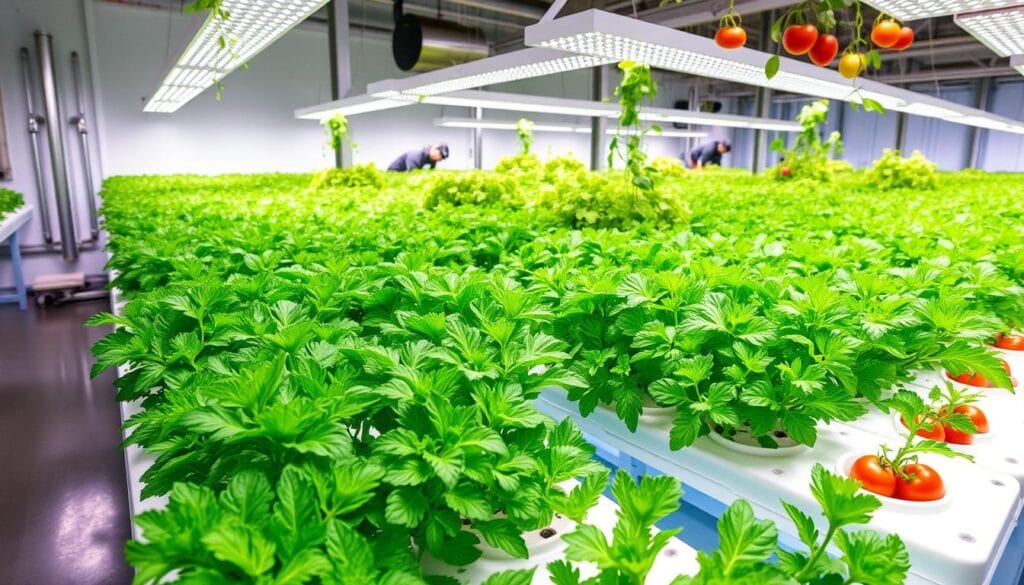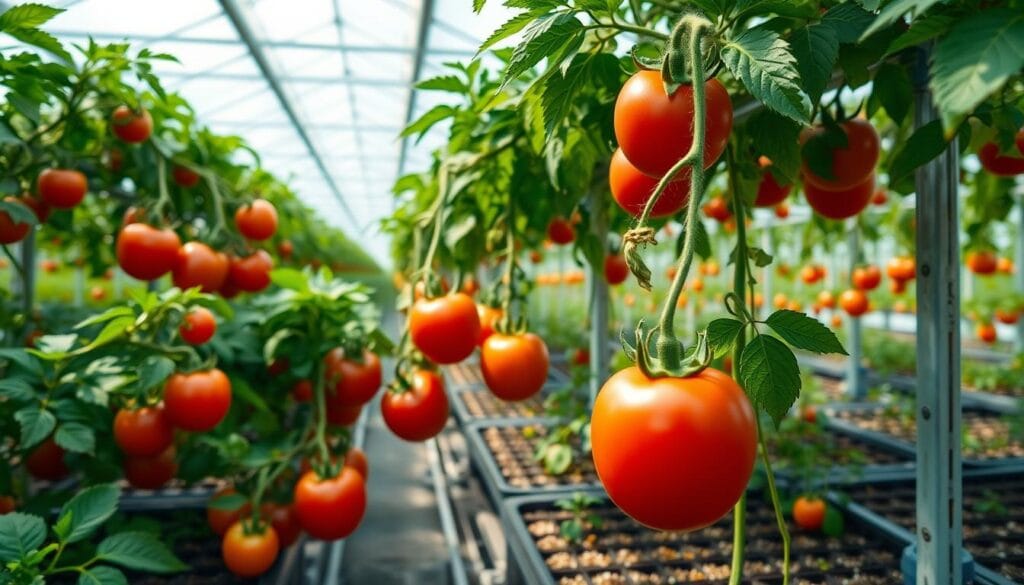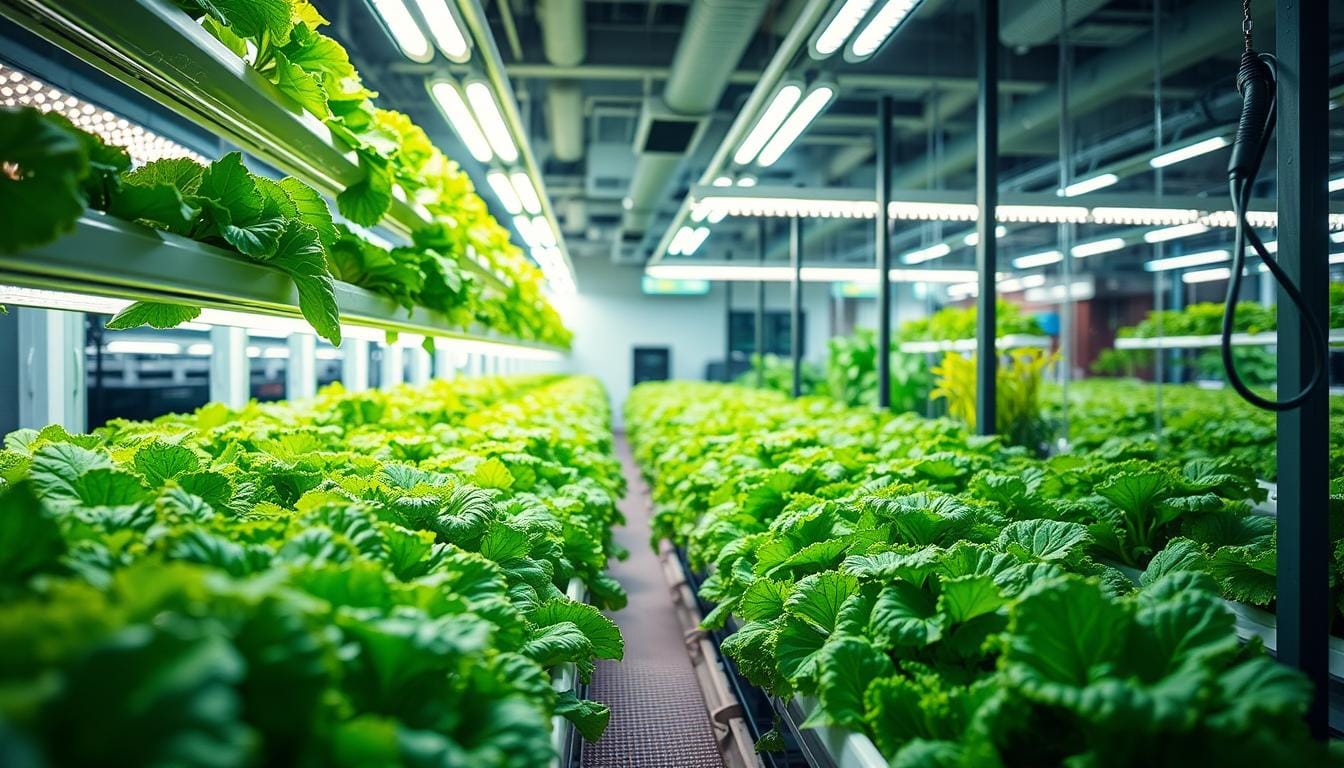Pros of Hydroponics include solving critical challenges like food shortages and land scarcity. This soil-free method enables plants to grow in nutrient-rich water, making it eco-friendly and efficient. With hydroponics, farmers can increase food production, use less space, and conserve water—benefiting both the planet and agriculture.
Plants in hydroponics grow 30-50% faster and produce more than those in soil. This is great because the world’s population is growing fast. We need new ways to farm that are efficient and productive.
Key Takeaways
- Hydroponic farming allows for faster plant growth and higher yields compared to traditional methods.
- Hydroponic systems use 80% less water, 90% less land, and 95% less shipping fuel than traditional field-grown produce.
- Hydroponic farming eliminates the risk of soil erosion, preserving land and ensuring sustainable farming practices.
- Hydroponic setups enable year-round cultivation, ensuring a consistent supply of fresh produce.
- Hydroponically grown produce often exhibits higher concentrations of vitamins, minerals, and antioxidants.
Understanding Modern Hydroponic Farming Systems
Pros of Hydroponics: Hydroponic farming has changed how we grow food by offering systems tailored to various growing needs. The pros of hydroponics include efficient resource usage, enabling farmers to grow more food with fewer resources. These benefits make hydroponics a popular choice for modern farming practices
Nutrient Film Technique (NFT)
The Nutrient Film Technique (NFT) is a well-liked method. It keeps the roots of plants in a constant flow of nutrients. This helps plants grow well and absorb nutrients better.
NFT systems work well for leafy greens, herbs, and some vegetables. These plants do great in the constant flow of nutrients.
Ebb and Flow Systems
Ebb and Flow systems, also known as Flood and Drain, flood and drain the roots of plants. This cycle of flooding and draining gives plants the nutrients they need. It also lets the roots get oxygen, helping plants grow well.
Drip and Aeroponic Solutions
Drip systems give water and nutrients directly to the roots of plants. This method is good for big farms because it lets farmers control how much nutrients plants get. Aeroponic systems hang plants in the air and mist their roots with nutrients. This helps plants grow fast and have strong roots.
These hydroponic systems have many benefits. They save water, use space well, and help plants grow better. By choosing the right system, farmers can make the most of hydroponics perks. They can grow food in a way that’s good for the planet and efficient.
Water Conservation: The Environmental Impact
Hydroponic farming is a water-efficient way to grow plants, unlike traditional soil-based farming. It saves up to 70-80% more water by recirculating nutrient solutions and reducing waste. This makes hydroponics a green choice, using up to 90% less water than traditional farming.
Hydroponics delivers nutrients directly to the roots, unlike traditional farming. This method saves water by avoiding evaporation and runoff. It also cuts down on the use of harmful chemicals, making it better for the environment.
Hydroponics helps reduce the carbon footprint of farming. It uses less energy with LED lighting and efficient climate control. Plus, hydroponic farms near cities cut down on food miles and emissions from transport.
“Hydroponics offers a sustainable solution to water scarcity, reducing the environmental impact of traditional farming while delivering high-quality, nutrient-rich produce.”
As water becomes scarcer, hydroponics’ water-saving benefits grow. New technologies like hydrogels and smart irrigation systems improve water use. These advancements help growers save water and support global water sustainability.
Space Efficiency and Urban Farming Potential
Hydroponic systems are super efficient with space, perfect for city farming. They use vertical growing to make the most of small areas. This means more food can be grown in tight spots, helping cities grow their own food.
Vertical Growing Solutions
Vertical hydroponics stack plants to increase yield per square foot. This method cuts labor costs by up to 30%. Eden Green Technology shows how it uses 98% less water and 90% less light than old farming.
Rooftop and Indoor Applications
Hydroponics can grow food in unexpected places like rooftops and indoors. This brings fresh produce right to people, cutting down on food transport. It also helps feed those in need by donating up to 10% of what’s grown.
Container Farming Possibilities
Container farming is another big step in urban hydroponics. It lets anyone grow food, even with little space. These easy-to-use systems bring healthy food to city folks, helping communities thrive.
| Metric | Vertical Farming | Traditional Farming |
|---|---|---|
| Water Usage | 98% less water | High water consumption |
| Energy Usage | 90% less light energy | High energy demands |
| Land Usage | 99% less land | Requires large tracts of land |
| Food Miles | 85% fewer food miles | Long-distance transportation |
Hydroponics are changing city farming, making it more efficient and green. They offer new ways to grow food in tight spaces. This is a big step towards fresh, local food in cities.
Year-Round Growing Capabilities
Hydroponic farming lets us grow food all year round. It breaks free from the old ways of farming. With advanced climate control, hydroponics keeps the produce fresh and healthy, no matter the season.
In places with tough weather or short growing seasons, hydroponics is a game-changer. It lets us control everything plants need to grow well. This means crops can grow in perfect conditions all year, giving us plenty of fresh food.
- Hydroponic farming provides 45 times more food production compared to traditional agriculture.
- Hydroponic systems maximize usable space, allowing for vertical growth which increases yield per square foot.
- Hydroponics breaks seasonal constraints, enabling year-round crop cultivation.
- Hydroponic grown plants can yield up to 18 harvests per year compared to the average 3 harvests from soil farming.
Hydroponics is not just convenient; it’s also good for the planet. It uses up to 90% less water than traditional farms. Plus, it doesn’t need pesticides, making the food safer and cleaner.
“Hydroponic farming provides a reliable, year-round source of fresh and nutritious produce, empowering communities to overcome the limitations of seasonal agriculture.”
As the world’s population grows, so does the need for good food. Hydroponic farming’s ability to grow food all the time, control the climate, and protect the environment makes it a key player in the future of farming.
Hydroponics Pros: A Complete System Analysis
Hydroponics is a way to grow plants without soil. It’s all about using resources wisely, working efficiently, and controlling quality. These key points make hydroponics a top choice for sustainable farming.
Resource Optimization
Hydroponics is great at saving water. It uses up to 90% less water than farming with soil. This is important because most of the world’s freshwater is used for farming.
It saves water by recycling and reusing nutrients. This means very little waste.
Production Efficiency
Hydroponics is also very efficient in growing plants. It delivers nutrients precisely, helping plants grow faster and stronger. This leads to bigger harvests and easier farming.
Quality Control Benefits
Hydroponics also helps control the growing environment. Growers can adjust conditions for better plant health and more food. This means less need for harmful chemicals and fewer pests.
This results in cleaner, healthier food. It meets high standards of safety and sustainability.
Hydroponics combines efficiency and productivity. It’s a promising solution for modern farming and food security challenges.
| Hydroponic Advantage | Key Benefit |
|---|---|
| Water Conservation | Up to 90% less water usage compared to traditional farming |
| Nutrient Efficiency | Precise control over macro and micronutrient delivery for superior yields |
| Quality Control | Ability to adjust growing conditions for optimal plant health and minimal pest/chemical usage |
“Hydroponics provides a vision for the future of sustainable agriculture, merging resource efficiency with quality control to feed an expanding population.”
Enhanced Crop Yields and Growth Rates
Hydroponics offers more than just water savings and year-round growing. It boosts crop yields and growth rates significantly. Plants get direct access to nutrients, growing 25-30% faster than in soil.
Hydroponic systems control light, temperature, and nutrients perfectly. This precision leads to higher productivity and more crops. For example, farmers can grow up to 210 pounds of barley fodder daily with systems like CropKing’s.
Adding AI and big data to hydroponics improves farming. It helps manage resources better and makes crops more resilient. Growers can optimize light, automate controls, and save water, leading to more yields and lower costs.
“Hydroponic farming enables the cultivation of a diverse range of crops, from leafy greens to fruits, catering to consumer preferences and expanding revenue opportunities.”
The global hydroponics market was worth $5.2 billion in 2023. It’s growing fast, with a CAGR of 8.5%, and is expected to hit $10.8 billion by 2032. This growth shows the demand for high-quality, nutrient-rich produce from hydroponics. It helps meet the global need for fresh, sustainable food.

Reduced Pesticide Usage and Cleaner Produce
Hydroponics is changing farming, making it sustainable and eco-friendly. It cuts down on pesticide use and gives us cleaner, safer food.
Pest Management in Controlled Environments
Hydroponics has a big edge in fighting pests. It doesn’t need soil, making it hard for pests to survive. This means less pesticide use and safer food for us.
Chemical-Free Growing Methods
Hydroponics grows plants without chemicals. It uses special nutrient solutions instead. This method is better for the environment and gives us pesticide-free food.
Food Safety Advantages
Hydroponic crops are safer from pesticides. They grow in clean, controlled spaces. This lowers the chance of foodborne illnesses, making our food healthier.
The need for hydroponics assets and food safety is growing. Hydroponics shows a bright future for farming that’s good for our planet and our health.
| Advantages of Hydroponic Farming | Conventional Farming |
|---|---|
| Reduced pesticide usage | Reliance on synthetic pesticides |
| Cultivation of pesticide-free produce | Presence of chemical residues on crops |
| Controlled environments for optimal pest management | Increased exposure to pests and weeds |
| Enhanced food safety and quality control | Potential for contamination and foodborne illnesses |
“Hydroponics provides an eco-friendly and sustainable approach to modern agriculture, yielding clean, pesticide-free produce that emphasizes consumer health and environmental safety.”
Nutritional Benefits and Taste Profiles
Hydroponic produce often has amazing nutritional value and taste. Hydroponic farming lets farmers control growing conditions closely. This means they can tweak nutrient levels for better flavor and nutrition.
Hydroponic crops usually have more consistent and balanced nutrients than soil-grown ones. Farmers adjust the nutrient solution to give plants the right vitamins, minerals, and antioxidants. This ensures the crops grow well and are full of nutrients.
| Nutrient Comparison | Hydroponic Tomatoes | Soil-Grown Tomatoes |
|---|---|---|
| Vitamin C | 12.5 mg/100g | 10.2 mg/100g |
| Lycopene | 9.8 mg/100g | 8.1 mg/100g |
| Potassium | 290 mg/100g | 240 mg/100g |
The taste of hydroponic and soil-grown crops can vary. But hydroponic systems often produce crops with fresher, more vibrant flavors. Farmers can adjust sun, temperature, and nutrients to create unique tastes.
“Hydroponic tomatoes tend to have a more intensified flavor profile compared to their soil-grown counterparts, with a balance of sweetness, acidity, and subtle nuances that can be customized to the consumer’s preferences.”
Hydroponic systems let farmers create crops with amazing taste and nutrition. This makes them a great choice for health-conscious eaters and chefs.

Commercial Applications and Industry Impact
Hydroponics is changing the game in many industries. It’s a soil-less farming method that’s both versatile and sustainable. It’s being used in healthcare, education, and urban farming, changing how we grow and eat food.
Healthcare Sector Integration
Healthcare places are at the forefront of using hydroponics. They grow fresh food right on-site. This means patients get better meals and the environment benefits too.
Educational Institutions
Schools are adding hydroponics to their STEM classes. It teaches students about sustainable farming. They learn about saving water, using space wisely, and cutting down on pesticides.
Urban Agriculture Initiatives
Urban farming projects use hydroponics to help those without access to food. They set up systems in empty lots and rooftops. This lets people grow their own food, improving food security and community spirit.
Hydroponics is making a big impact in many fields. It’s helping patients, teaching the next generation, and making our food systems more sustainable. It’s a key player in our future.
Conclusion
Hydroponic farming is a key solution to our global food problems. It saves water, uses less space, grows more food, and can grow food all year. This makes it a great choice for the future of farming.
The advantages of hydroponics pros are obvious. It uses much less water, grows crops faster, and makes them better. It’s a game-changer for city farming and a greener way to farm than old methods.
Looking ahead, hydroponics is a game-changer for farming. It tackles food security issues and reduces farming’s harm to the environment. By using hydroponics, we can ensure a steady and green food supply for future generations.

